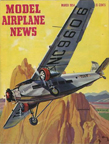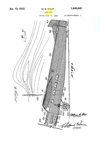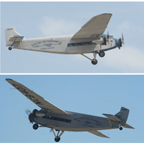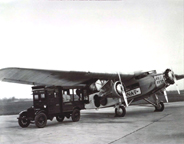March, 1954

Ford Tri-Motor "Tin Goose"
Model Airplane News Cover Art for March, 1954
by Jo Kotula
Click to Enlarge
The Ford Trimotor was an American three engine civil transport aircraft first produced in 1925 by Henry Ford and continued in production until June 7, 1933. Throughout its lifespan a total of 199 aircraft were produced. Although designed for the civil market, the aircraft was also used by the military and was sold all over the world. Unlike his famous Ford Model T cars, trucks and farm tractors, Ford did not make the engines for these aircraft.


William Stout's Patent for a Corrugated Aluminum Airplane
Henry Ford added the other two engines for reliability
Patent No. 1,840,643
Click to Enlarge
In the early 1920s Henry Ford, along with a group of 19 other investors including his son Edsel, invested in the Stout Metal Airplane Company. In 1925, Ford bought Stout' aircraft designs. Ford adapted the single engined Stout design with three Wright air-cooled radial engines. After a series of test aircraft and a suspicious fire causing the complete destruction of all previous designs, the 4-AT and 5-AT emerged. The Ford Trimotors used an all-metal construction — not a revolutionary concept, but certainly more advanced than the standard construction techniques in the 1920s, allowing Ford to claim it was "the safest airliner around." Its fuselage and wings were constructed of aluminum and corrugated for added strength although the incipient drag reduced overall performance. This has become something of a trademark for the Trimotor. Transcontinental Air Transport, which later became part of Trans World Airlines, used the aircraft to begin its transcontinental air service from San Diego to New York in 1929.



Ford Tri-Motor "Tin Goose"
Click to Enlarge
Like his cars and tractors, these Ford aircraft were well designed, relatively inexpensive, and reliable (for the era). The combination of metal structure and simple systems lead to a reputation for ruggedness. Rudimentary servicing could be accomplished "in the field" with ground crew able to work on engines using scaffolding and platforms. In order to fly into normally inaccessible sites, the Ford Trimotor could be fitted with skis and floats.. While Ford did not make a profit on its aircraft business, Ford's reputation lent credibility to the infant aviation industry, and Ford helped introduce many aspects of the modern aviation infrastructure, including paved runways, passenger terminals, hangars, airmail, and radio navigation.
In the late 1920s, the Ford Aircraft Division was reputedly the "largest manufacturer of commercial airplanes in the world." Alongside the Ford Trimotor, a new one-passenger commuter aircraft, Sky Flivver had been designed and flown in prototype form but never entered series production. The Trimotor was not to be Ford's last venture in aircraft production. During World War II, he built the largest aircraft manufacturing plant in the world at the Willow Run, Michigan plant and assembled thousands of B-24 Liberator bombers under license from Consolidated Aircraft.
Here is a video of the Ford Tri-Motor "Tin Goose":
Click Here for more information about the Ford Tri-Motor "Tin Goose".

Click to go back and select another cover.
Counter for the Entire Site (not just this page..)
Home | About Lindy | Last Week's Reviews | Upcoming Events | 1940s Collecibles
The Guide - Establishments - Travel - Accessories
Music | Links | Photo Gallery | Extras | Contact